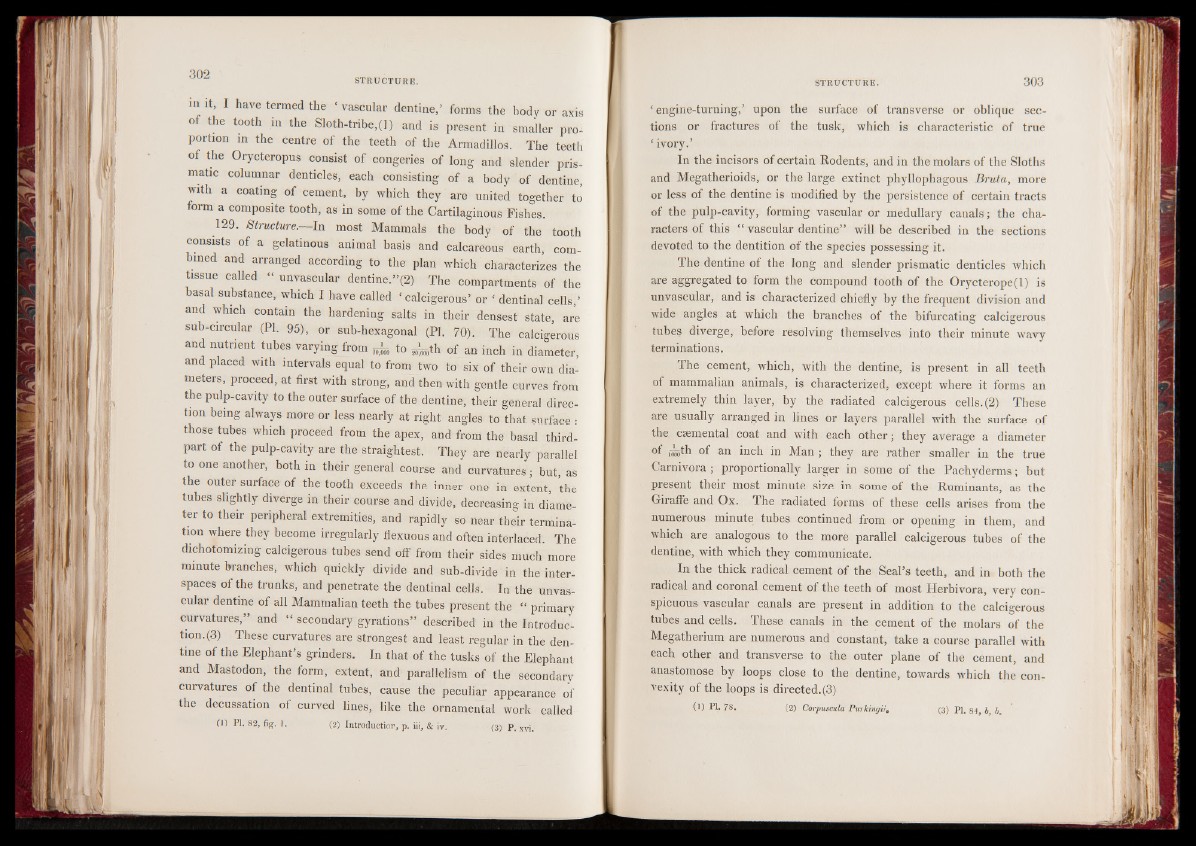
in it, I have termed the ‘ vascular dentine,’ forms the body or axis
of the tooth in the Sloth-tribe, (1) and is present in smaller proportion
in the centre of the teeth of the Armadillos. The teeth
of the Orycteropus consist of congeries of long and slender prismatic
columnar denticles, each consisting of a body of dentine
with a coating of cement, by which they are united together to
form a composite tooth, as in some of the Cartilaginous Fishes.
129. Structure. In most Mammals the body of the tooth
consists of a gelatinous animal basis and calcareous earth, combined
and arranged according to the plan which characterizes the
tissue called “ unvascular dentine.”(2) The compartments of the
basal substance, which I have called ‘ calcigerous’ or £ dentinal cells,’
and which contain the hardening salts in their densest state, are
sub-circular (PL 95), or sub-hexagonal (PI. 70). The calcigerous
and nutrient tubes varying from ^ to ^ t h of an inch in diameter,
and placed with intervals equal to from two to six of their own diameters,
proceed, at first with strong, and then with gentle curves from
the pulp-cavity to the outer surface of the dentine, their general direction
being always more or less nearly at right angles to that surface :
those tubes which proceed from the apex, and from the basal third-
part of the pulp-cavity are the straightest. They are nearly parallel
to one another, both in their general course and curvatures; but, as
the outer surface of the tooth exceeds the inner one in extent, the
tubes slightly diverge in their course and divide, decreasing in diameter
to their peripheral extremities, and rapidly so near their termination
where they become irregularly flexuous and often interlaced. The
dichotomizing calcigerous tubes send off from their sides much more
minute branches, which quickly divide and sub-divide in the interspaces
of the trunks, and penetrate the dentinal cells. In the unvascular
dentine of all Mammalian teeth the tubes present the “ primary
curvatures,” and “ secondary gyrations” described in the Introduction.
(3) These curvatures are strongest and least regular in the dentine
of the Elephant’s grinders. In that of the tusks of the Elephant
and Mastodon, the form, extent, and parallelism of the secondary
curvatures of the dentinal tubes, cause the peculiar appearance of
the decussation of curved lines, like the ornamental work called
01 PI. 82, fig. I. (2) Introduction, p. iii, & iv. (3) P.xvi.
‘ engine-turning,’ upon the surface of transverse or oblique sections
or fractures of the tusk, which is characteristic of true
‘ ivory.’
In the incisors of certain Rodents, and in the molars of the Sloths
and Megatherioids, or the large extinct phyllophagous Bruta, more
or less of the dentine is modified by the persistence of certain tracts
of the pulp-cavity, forming vascular or medullary canals; the characters
of this “ vascular dentine” will be described in the sections
devoted to the dentition of the species possessing it.
The dentine of the long and slender prismatic denticles which
are aggregated to form the compound tooth of the Orycterope(l) is
unvascular, and is characterized chiefly by the frequent division and
wide angles at which the branches of the bifurcating calcigerous
tubes diverge, before resolving themselves into their minute wavy
terminations.
The cement, which, with the dentine, is present in all teeth
of mammalian animals, is characterized, except where it forms an
extremely thin layer, by the radiated calcigerous cells. (2) These
are usually arranged in lines or layers parallel with the surface of
the csemental coat and with each other; they average a diameter
°f iifflth of an inch in Man ; they are rather smaller in the true
Carnivora ; proportionally larger in some of the Pachyderms; but
present their most minute size in some of the Ruminants, as the
Giraffe and Ox. The radiated forms of these cells arises from the
numerous minute tubes continued from or opening in them, and
which are analogous to the more parallel calcigerous tubes of the
dentine, with which they communicate.
In the thick radical cement of the Seal’s teeth, and in both the
radical and coronal cement of the teeth of most Herbivora, very conspicuous
vascular canals are present in addition to the calcigerous
tubes and cells. These canals in the cement of the molars of the
Megatherium are numerous and constant, take a course parallel with
each other and transverse to the outer plane of the cement, and
anastomose by loops close to the dentine, towards which the convexity
of the loops is directed.(3)
(1) PI. 78. (2) Corpuscula Pmkingii, (3) p], 34 } j.